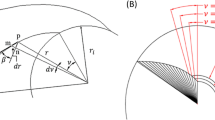In this work, the effect of rotor geometry on the H−Q curves of the Sputnik implantable pediatric rotary blood pump was studied. Load sensitivity was calculated for different input angles of the pump impeller and diffuser blades. Hydraulic efficiency and shear stress were determined for each modification of the pump design. The study showed that variation of the input angles of the impeller and diffuser blades had a significant effect on the load sensitivity of the pump. An almost twofold increase in the load sensitivity was achieved (from 0.03420 to 0.05957 L·min−1·mm Hg−1).
Similar content being viewed by others
References
Giridharan G. A., Lee T. J., Ising M. et al., “Miniaturization of mechanical circulatory support systems,” Artif. Organs, 36, No. 8, 731-758 (2012).
Petukhov D. S., Selishchev S. V., and Telyshev D. V., “Development of left ventricular assist devices as the most effective method of treatment of acute cardiac failure,” Med. Tekh., No. 6, 37-39 (2014).
Kyo S., Ventricular Assist Devices in Advanced-Stage Heart Failure, Springer Japan (2014).
Rose E. A., Gelijns A. C., Moskowitz A. J. et al.. “Long-term use of a left ventricular assist device for end-stage heart failure,” N. Eng. J. Med., 345, No. 20, 1435-1443 (2001).
Kirklin J. K., Naftel D. C., Pagani F. D. et al., “Sixth INTERMACS annual report: A 10,000-patient database,” J. Heart Lung Transplant., 33, No. 6, 555-564 (2014).
Cheung A., Chorpenning K., Tamez D. et al., Innovations (Philadelphia, Pa.), 10, No. 3, 151-156 (2015).
Stepanoff A. J., Centrifugal and Axial Flow Pumps, J. Wiley (1948).
Frazier O., Khalil H. A., Benkowski R. J., and Cohn W. E., “Optimization of axial-pump pressure sensitivity for a continuous-flow total artificial heart,” J. Heart Lung Transplant., 29, No. 6, 687-691 (2010).
Salamonsen R. F., Mason D. G., and Ayre P. J., “Response of rotary blood pumps to changes in preload and afterload at a fixed speed setting are unphysiological when compared with the natural heart,” Artif. Organs, 35, No. 3, 47-53 (2011).
Fukamachi K., Shiose A., Massiello A. et al., “Preload sensitivity in cardiac assist devices,”, Ann. Thorac. Surg., 95, No. 1, 373-380 (2013).
Petukhov D. S. and Telyshev D. V., “Analysis of the preload and afterload sensitivity of the Sputnik rotary blood pump,” Med. Tekh., No. 6, 27-30 (2015).
Khalil H. A., Cohn W. E., Metcalfe R. W., and Frazier O. H., “Preload sensitivity of the Jarvik 2000 and HeartMate II left ventricular assist devices,” Am. Soc. Artif. Organs J., 54, No. 3, 245-248 (2008).
Selishchev S. and Telyshev D., “Ventricular assist device Sputnik: Description, technical features and characteristics,” Trends Biomat. Artif. Organs, 29, No. 3, 207-210 (2015).
Selishchev S. V. and Telyshev D. V., “Optimisation of the Sputnik- VAD design,” Int. J. Artif. Organs, 39, No. 8, 407-414 (2016).
Menter F. R., “Two-equation eddy-viscosity turbulence models for engineering applications,” Amer. Inst. Aeronautics Astronautics J., 32, No. 8, 1598-1605 (1994).
https://uiuc-cse.github.io/me498cm-fa15/lessons/fluent/refs/ANSYS%20Fluent%20Theory%20Guide.pdf
Fraser K. H., Zhang T., Taskin M. E. et al., “A quantitative comparison of mechanical blood damage parameters in rotary ventricular assist devices: Shear stress, exposure time and hemolysis index”, J. Biomech. Eng., 134, No. 8 (2012).
Thamsen B., Blümel B., Schaller J. et al., “Numerical analysis of blood damage potential of the HeartMate II and HeartWare HVAD rotary blood pumps,” Artif. Organs, 39, No. 8, 651-659 (2015).
Author information
Authors and Affiliations
Corresponding author
Additional information
Translated from Meditsinskaya Tekhnika, Vol. 50, No. 6, Nov.-Dec., 2016, pp. 45-49.
Rights and permissions
About this article
Cite this article
Telyshev, D.V., Denisov, M.V. & Selishchev, S.V. The Effect of Rotor Geometry on the H−Q Curves of the Sputnik Implantable Pediatric Rotary Blood Pump. Biomed Eng 50, 420–424 (2017). https://doi.org/10.1007/s10527-017-9669-8
Received:
Published:
Issue Date:
DOI: https://doi.org/10.1007/s10527-017-9669-8



